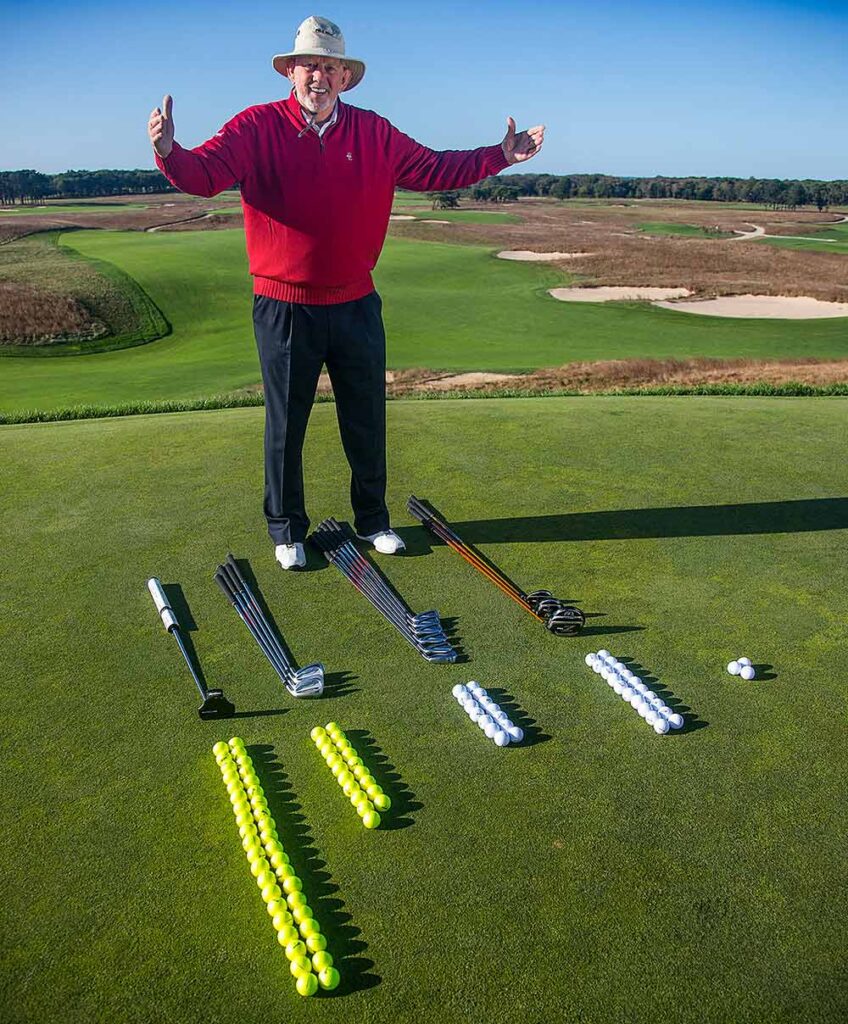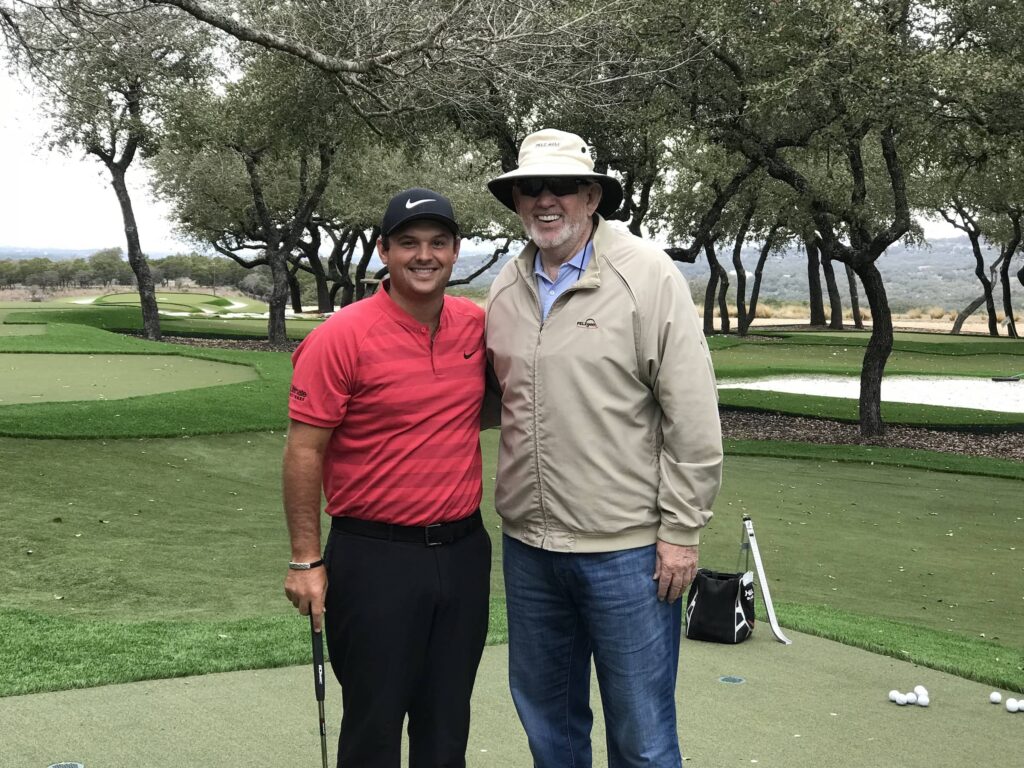PORT ST. LUCIE, Florida – One of golf’s most influential instructors and innovators, Dave Pelz, whose long career lovingly scrutinized the short game, passed away on March 23 at his home in Dripping Springs, Texas. A former NASA scientist turned golf researcher, Pelz revolutionized how the game is taught, played, and understood from playing shots from 100 yards in to refining the technique of putting.
Pelz was among the first to scientifically study golf performance and identify the short game as the primary factor in scoring success. This groundbreaking insight became the foundation for his teachings, shifting the focus of scoring more toward wedge play and putting.
Born in Indiana and raised in Kentucky, Pelz took up golf early and earned a four-year golf scholarship to Indiana University, majoring in physics with minors in mathematics, philosophy and astronomy, and where, he thought, he would prepare to play pro golf. However, luckily for all us clueless duffers and the many grateful pros who benefitted from his meticulous research, he gave up that dream because, as he wrote later, “I kept being beaten by other Big Ten golfers… especially a kid from Ohio State named Nicklaus.” Thank you, Jack!

Pelz spent 14 years at NASA’s Goddard Space Flight Center conducting experiments on the atmosphere of the earth and other planets. However, his passion for golf proved too strong and in 1975 he left NASA to focus on analyzing the game, using his scientific background to develop a data-driven approach unlike anything else at the time. His research and teaching made him known on the Tour as “Professor Putt.“
Pelz’s creativity led to numerous inventions and training aids, which continue to be used by golfers worldwide. His Pelz Teacher Putter helped golfers develop a more consistent and repeatable stroke, while the Dave Pelz Putting Tutor became a staple for tour players looking to improve their alignment and roll. One of his most significant contributions was the “3X4 Wedge System,” which transformed the way golfers controlled the distance of their wedges, improving accuracy and scoring efficiency.
He is survived by his wife, JoAnn, their five children, and nine grandchildren.
Those who wish to share their thoughts or memories are invited to a special tribute page at www.pelzgolf.com/tribute/.
I interviewed Dave Pelz a number of years ago when I had a monthly column for “New England Golf Monthly” called “Celebrity Golfer.” Here is the reprint:

CELEBRITY GOLFER: DAVE PELTZ
The short-game woes of a young Dave Pelz should be celebrated by all those golfers whose short-game woes have been assuaged by his expertise. For, had Pelz succeeded on Tour as was his dream, the world of golf would undoubtedly be bereft of his teachings.
Pelz attended Indiana University on a golf scholarship and played well, except when he lost to Jack Nicklaus 22 times. Although Pelz was a quality amateur, he realized that his short game fell, well, just short.
So, Plan B in 1961 was to work for NASA at the Goddard Space Flight Center in MD, where he became a senior scientist in the Explorer program. In his spare time, Pelz also used his research methods and physics to learn exactly how the mechanics of the putting stroke influence the roll of the ball.
In 1976, Pelz resigned from NASA to form his own company, Preceptor Golf, which marketed his first innovation, the Teacher Putter. He then invented “The True Roller,” which makes a perfect stroke, and was the basis for his exhaustive study of putting. In 1977, he started a three-year analysis of every shot in golf and concluded that 60% of a player’s score comes from within 100 yards, hence the short-game emphasis.
This scrutiny of the game encouraged Pelz to begin teaching, to write articles for “Golf Magazine,” to publish books, to appear on the Golf Channel, and to produce videos. In 1982, he developed his first Short Game and Putting facility, and today he has his Scoring Game Schools located throughout the country and abroad.
Pelz’s methods paid off first for Andy North, who won the 1978 US Open. Other tour professionals who sought his advice include Beth Daniel, Steve Elkington, Jane Geddes, Lee Janzen, Tom Kite, Patrick Reed, Vijay Singh, Payne Stewart, D. A. Weibring, and Mike Weir. His most famous student has been Phil Mickelson, of course, who said to his mentor, “I couldn’t have won my Majors without you.”
Pelz has written several best-selling books including his “10 Minutes a Day to Better Putting,” “Damage Control,” “Golf Without Fear,” “Putting Bible,” “Putt Like the Pros,” and “Short Game Bible.” Pelz holds 20 patents on golf equipment, but his most recognizable creations are the 2-Ball and 3-Ball putters that he has licensed to Callaway Golf for the Odyssey line. With more than 5,000,000 of these on greens around the world, they are the best-selling golf club ever.

LBM: What were your responsibilities with NASA?
DP: Basically, we were studying the earth’s atmosphere based on the sun’s radiation and behavior. Weather forecasting was in its infancy in the 1960’s, with an accuracy rate of 7-8%. Today, because of these and continuing studies, it’s around 70-80%.
LBM: Did losing to Jack 22 times have an impact on your career?
DP: Yes, he helped convince me that Goddard needed me more than the Tour. Of course, I did not know how good Jack really was. I just knew I was not good enough.
LBM: When you are not doing your research at the Pelz Golf Institute in Spicewood, TX, (near Austin) what else keeps you busy?
DP: I visit all seven of my schools. I get great pleasure from the teaching I do and from watching players improve their short games. I also spend a lot of time interviewing Tour players. Phil and I work together frequently, and currently we are preparing for the US Open.
LBM: What is your next project?
DP: A book, planned for 2013, that will be on how to read greens. Too many golfers, Phil included, often don’t see what is really there and under read the breaks. I’ve been doing a lot of research and am excited about the prospects of what I am learning.

LBM: Which one of your patents or innovations is your favorite?
DP: The two-ball and three-ball putters. Because the ball images on the club’s head are easy to align with the ball itself, golfers are almost automatically better putters. Aiming is the first major step in the putt’s success.
LBM: How often do you get to play golf now? Do you belong to a club?
DP: Rarely in past years because I have been so busy. This year my goal has been to play once a week, and I have played about 16 times so far. My short game is OK, but my driving is too wayward. I belong to Summit Rock and Escondido, both near Austin.
LBM: What are your favorite golf courses.?
DP: Augusta National, Pebble Beach, and Pine Valley.
LBM: Who would be in your Dream Foursome today? Of any time period?
DP: Whenever my three sons—David, Eddie, and Mark—can play, that’s a dream for me and lots of fun. Walter Hagen, Ben Hogan, Gene Littler, and Jack Lemmon. Peter Jacobsen and I so wanted Jack to make the cut at the Crosby Pro-Am. He missed it 30 straight years.
LBM: Which pros are the best putters?
DP: Aaron Baddeley, Luke Donald, Brad Faxon, and Brandt Snedeker.
LBM: Is putting an innate ability?
DP: No, putting is not a God-given talent. It can be a learned skill. The most common flaw is that players tend to rotate their forearms and/or break their wrists through impact, preventing the clubhead from being square at impact. This flaw is why the Belly Putter and the Long Putter have become so popular. By locking the club against the body, the golfer’s stroke flows through impact without any breaking down. The ball rolls where it is aimed.
LBM: Any regrets that you didn’t get a chance to play on Tour?
DP: No, not at all. Once I started to do my research, my niche in golf became evident to me. My calling is to teach the short game as effectively as I can. I want players to score better and enjoy the game more.
www.peltzgolf.com

As a caddie, greenkeeper, and Ouimet Scholar from Marshfield Country Club on Boston’s South Shore, Leigh developed his love for the game at an early age. The BA from Amherst College and MA from Dartmouth prepared him for his 36-year career in education, most of it teaching Advanced Placement English and coaching varsity golf. In 1986, a sabbatical from teaching students to writing stories for “Golf World” magazine prepared him for his second career in golf journalism. Leigh is a low-handicap golfer who has won the Golf Writers Association of America’s championship seven times. He is currently a member of Southers Marsh Golf Club in Plymouth, MA, and PGA Golf Club in Port St. Lucie, FL.










